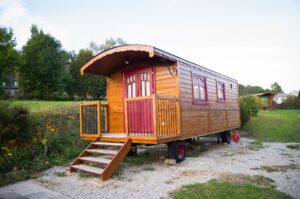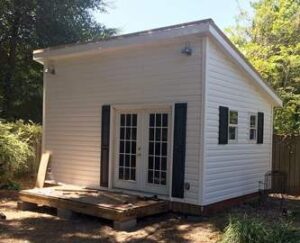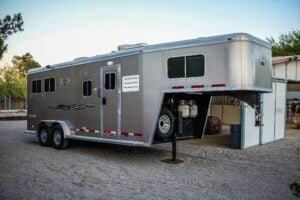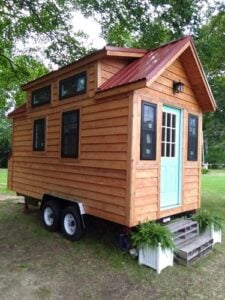Blog

Traveling tiny houses – RV vs. Tiny home, Which One is Better?
Traveling in an RV or Tiny House, Which One is Better?
The tiny house movement isn’t just about downsizing and setting up a living space somewhere off-grid. Part of the appeal is being able to travel in your dream home from place to place, laying down temporary roots wherever you go. You can do that with a tiny home on wheels or an RV (recreational vehicle), the latter of which is built for road trips and staying at campgrounds. It can be tough to figure out which will be the best for you, so we’ll help you weigh out the pros and cons.
You’ll find a list below of some of the most important advantages and disadvantages for living in a traveling tiny house or RV to help you make your choice. Let’s hit the road to Colorado with the benefits of a tiny home on wheels!
Advantages of a Tiny Home

They look more traditional:
For some people, RVs might just feel like a temporary living space, but tiny homes can give you that home sweet home feeling you’re looking for. They look and feel more like a traditional full size house, so overall, you’ll probably feel more like it’s a permanent home — even if it’s on wheels. It’s easier to make them look more well designed (we’ll get into this more next) for the most part, and that’s great to consider if you plan on blogging or taking photos of your space to share with others. Imagine that it’s an AirBnB on wheels!
They’re easier to customize:
Compared to RVs, tiny homes can be a lot easier to customize, since you’ll often be starting from the ground up and can plan out the foundation from the jump. It isn’t as easy to gut out and alter an RV once you buy one, although some manufacturers can sell you one with a custom floor plan. Most of the time, though, you can control exactly how you want your tiny home to look, and it’s a lot easier to build DIY additions or make upgrades later on.
They’re usually more insulated:
A major benefit for tiny homes is that they’re closer to real homes in terms of the foundation and insulation. It’s so much easier to control the temperature of your space in a tiny house compared to an RV. You’ll need to think about your comfort, and if you plan on living anywhere with harsh weather conditions, either cold or warm, you might want to consider a tiny house first.
Cons for Tiny House Travel

Traveling in a tiny home does have some downsides compared to RVs — here are some of the most important ones to consider.
They can have limited mobility:
You can use a towing vehicle of some sort to carry your wheeled tiny house from place to place when needed, but they aren’t as easy to transport as an RV, which is already designed for driving.
And, while tiny houses are generally more insulated and weatherproof, they might not be designed to be on the road for long periods of time. There’s lots of dust and debris on the road that can fling up into your house’s shingles or roof tiles, which can lead to damage over time. RVs account for this in the design process, so long journeys can be both easier and less damaging in the long run.
They’re more complicated to insure:
Tiny home owners need to be aware of the more complicated insurance process compared to RV campers. RV’s have strict regulations they need to follow (such as the RVIA), which means campgrounds and national parks feel more comfortable about letting them park overnight and they’re more straightforward to insure. Custom built tiny houses don’t have the same regulations, so they might not be allowed to park for an overnight stay. There’s also some grey area about whether you’ll qualify for a standard homeowner policy or RV insurance (if the home is on wheels), so you’ll need to check in with your insurance company beforehand.
They’re usually more expensive per square foot:
It may be a bit of a surprise, but tiny homes can end up costing more per square foot than an RV. Most tiny homes will be somewhere between $125 and $300 per square foot, while it’ll usually be somewhere in the low hundreds for RVs, especially if you’re buying an older used camper. On the bright side, the value of a tiny home won’t depreciate like it does for the vehicle, so it’ll be worth the investment if it can fit comfortably in your budget.
Advantages of an RV

RVs solve a lot of the problems commonly found in tiny homes. They’re homes on wheels designed for mobility, can be cheaper depending on the modifications, and they’re often more affordable per square foot than a tiny home, so you can have space for larger kitchens or a washer and dryer space. Here are another few advantages that can sweeten the deal:
You’ll blend in more easily:
Maybe you’re someone who doesn’t want all the attention that tiny homes get, and you’d just prefer to blend into the crowd and socialize on your own terms. You’re more likely to get that with an RV small camper — mobile tiny homes can pull crowds, especially if you’re parked in a campground and everyone wants a tour of your stylish space. RVs are the more common choice to travel with, so you won’t stand out with one.
Looking for a great camping site to explore in the US? Check out this lovely list of 20 of the best (and free!) campsites to park in.
They often have better sleeping arrangements:
With tiny homes, chances are your bedroom will be up in a loft above a space like your living room, since that’s one of the easier ways to place a bed and maximize your overall space. But, if you don’t want to (or are unable to) climb up and down stairs multiple times a day, that can be a huge deterrence. With some loft spaces you might be super close to the ceiling, too, and you could bump your head if you aren’t careful. RVs usually have a full bedroom on the ground floor, which means you can avoid the stairs.
It’s easier to get financing:
If you don’t have the money upfront for your new tiny home or RV, keep in mind that finding a bank loan for an RV is usually easier. They’re almost as common as car loans, except your financing period will likely be a lot longer. Banks are less likely to fund a tiny house that falls somewhere between a home and an RV, but it isn’t impossible, so be sure to ask your bank first to figure out all the details.
Cons for Living in an RV

RVs have their perks, but that doesn’t mean choosing one over a tiny home is easy — there are some downsides you’ll need to think about.
They’re more difficult to design well:
Part of the reason why tiny homes appear more popular is that they’re easier to make minimalist and beautiful — which makes for perfect social media posts to spread the word. There are some beautiful RVs, sure, but most of the time they don’t look the best, and it can take a lot more effort to pretty them up. There isn’t much that can be done about the outside of your RV, either. It will likely always look like a camper unless you’re willing to put in some extra time and money.
They generally use more energy to heat and cool:
RVs normally have some problems when it comes to extreme temperatures, since they aren’t as insulated as tiny homes. They aren’t great at keeping the heat and cold out, so you could end up spending a lot more money a month and energy in the long run, depending on where you are geographically. If you’re anywhere cold, you’ll definitely want to consider a well-insulated tiny house.
If you do happen to be set on RVs, hope is not lost — you can alter them and add insulation or hire someone to do it for you. It will just take some extra coin upfront, so factor that into your overall cost while budgeting.
Our final verdict
There isn’t a clear winner here. For people who prefer a minimalist aesthetic, a beautifully designed space that’ll bring lots of attention, and the feeling of a more permanent home, a tiny house will likely be what you’re after. If you’d rather avoid the complicated insurance, are working with a smaller budget, and don’t so much mind the camper aesthetic, then an RV sounds like a great choice for you. You’ll also probably want an RV if you plan to be on the road often.
Frequently Asked Questions
Now that you’ve learned some of the key differences between a tiny house or an RV when living on the road, you might still have some questions — here are our answers to a few of the most common ones. Be sure to leave a comment below if you still have any questions, stories, or advice to share.
What are some of the best trucks and tow vehicles?
If you’ve picked out a wheeled tiny home and need a new truck to tow it, not all vehicles can handle the task so there are a few important factors to consider. First, you’ll need to know how much your tiny house weighs. The heavier your house is, the more powerful your truck needs to be, while light weight homes might not need as strong of a truck. The tiny house company or manufacturers should be able to tell you how much it weighs after buying, but if you build it yourself, it’s a good idea to weigh all your materials and furniture beforehand and make a list or spreadsheet. Once you have the weight (or a ballpark of it) look for a truck with a suitable towing capacity.
Keep in mind, too, that most diesel engine cars can give you better towing capacity, since its torque is higher. But they can be a bit more expensive, especially since diesel can sometimes be more costly than regular gas fuel in the US.
Here’s a list of some of the newest truck and SUV models to check out first:
- 2022 Ford Expedition
- 2022 Ford Ranger XL
- 2022 Ram Chassis Cab
- 2022 Chevrolet Silverado 1500
- 2021 Chevrolet Tahoe
- 2021 GMC Yukon
What factors should I look into when looking to road-trip across the country with a tiny house?
There’s many logistics you’ll need to think about and manage on a road-trip across the country, and if you’re still building your home, it’s good to keep them in mind to set yourself up for success.
- Size: The larger and heavier your tiny house or travel trailer is, the more difficult it will be to transport from place to place. You might need a truck with a higher towing capacity, or a specific trailer that’ll make it easier to turn and maneuver.
- Parking: As we mentioned before, parking a tiny house overnight at campgrounds or national parks isn’t always easy. Some have more strict rules about overnight stays, and RVs might have an easier time, so it’s a good idea to plan out your route beforehand and make sure you know where you can park overnight.
- Weather: When planning your trip, think about the weather and seasons of your destination — if it’s going to be cold and snowy, make sure your tiny home is well insulated. Some areas might be super hot depending on the month, too, which might be uncomfortable depending on your heat tolerance.
- Budget: Before you embark on your journey, make sure you account for all expected (and unexpected!) costs: you don’t want to be stranded somewhere without any cash available. Also, keep in mind that the heavier your house, the more gas you’ll consume, so make sure that you plan accordingly in your budget. If you want to estimate your fuel costs, use this calculator from the U.S Department of Energy.
Can you live in a tiny house and still have a social life?
Of course! The beauty of mobile tony homes or RVs is that you can park anywhere you’d like (following all applicable laws), whether that’s in a tiny house community with other folks or off-grid in the middle of nowhere. If a social life is what you’re after, you’ll have lots to talk about with the other tiny home owners in the lot, and if you’d prefer to live in solitude instead, you can drive off into the sunset and find your own little corner of the world.